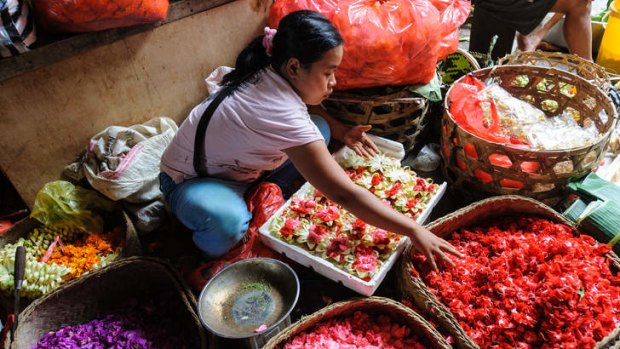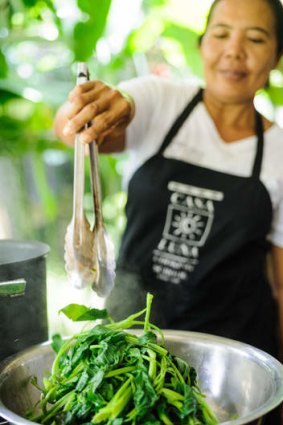
Best buys: Fresh is always best.Credit: Matthew Oldfield
Even the MasterChef generation can learn a thing or two from Bali's best chefs, writes Brigid Delaney.
At 8am, it's a little early to be looking at a bucket of eels. They are packed in, sliding by one another, ripe for the knife. I'm with a group of wannabe chefs. There are 14 of us, all in our 20s and 30s, on a market excursion before we return to the Casa Luna Indonesian cooking class in Ubud.
We are the MasterChef generation - an even mix of men and women - who've gorged ourselves on cooking shows. As a result the drill this morning is familiar: an early morning trip to a bustling food market in an exotic city, confronting the strange, slimy things that move in a sick-making way, the unidentified smelly fruits, the endangered species in a cage and the rich colours of flowers and spices.
At the entrance of the Ubud central market are women with gigantic baskets of flowers used for offerings. Around the corner in a central courtyard are the vegetable sellers; inside is meat, spices and knives.
I had passed the market a few mornings earlier at 4.30am. It's a proper working market, not just for tourist tat. Women weave through traffic with huge baskets of produce balanced on their heads, people drag sacks of grain across the streets, flower-sellers unload plucked blossoms illuminated by the headlights of passing motorbikes.
The abundance of fresh produce in Bali - combined with limited use of refrigeration in some villages - mean most Balinese go to the market daily, our guide Oleg explains.

Balinese home-style cooking.Credit: Matthew Oldfield
With many keen home cooks among us, our group is fascinated by the tools of the trade - knives, coconut graters, mortar and pestles and garlic crushers. Once our tour has finished, we walk the few blocks to the Second Honeymoon Lodge where an attractive patio area, with a long dining table has been set up for our cooking class and lunch.
Some of the group were disappointed we didn't shop for the actual cooking class at the market. Rather, the ingredients have been bought and delivered earlier in the day - and prepped. Beware also you won't have your own hob and wok at the cooking class. You do participate - but it's more "watch and learn" than "do and learn".
We start our class with a refreshing glass of hibiscus iced tea. The flowers were picked that morning and lime, lemon and sugar were added, along with hot water. We drink our tea and snack on local treats such as rice porridge in banana leaf.
Our teacher is Balinese cook Udey, although Casa Luna founder Janet DeNeefe also steps in to do lessons from time to time.
Udey is hilarious, talks non-stop - indoor volleyball, ping-pong, her children - and how useless Balinese men are in the kitchen. "She should be on The Daily Show," mutters one of the Aussie guys appreciatively.
She also outlined the role food plays in Balinese ceremonies and offerings.
For this class, we're focusing on Balinese home-style cooking.
Eight dishes to master - including mie goreng, tempe curry, roasted eggplant sambal, urab (a delicious fern and coconut salad), and dadar unti (green pancakes with coconut).
The tables are laden with freshly chopped ingredients. Our old friends from this morning - the eels - are there. They're dead now and appear to have shrunk. They'll be going in the sambal (although there will be another sambal prepared without them).
The freshly chopped plant ingredients are incredibly fragrant - the mixed scent of limes, homemade coconut oil, lemon-grass, garlic, onion chilli and ginger is enough to make me swoon.
We don aprons and take turns at using the mortar and pestle and prepping some of the vegetables.
The cooking is done mostly by Udey with some of us taking turns to stir the curry mixture in a giant wok. Most of the dishes seem to rely on the same base of chilli, lemongrass, garlic and ginger. As all chefs know, it's the prep - the grinding of these spices into a paste - that's far more time- consuming than cooking.
Prepping is fascinating given there's so much to learn: for example, the oil used is coconut oil, not the olive oil that I usually have at home when making an Indonesian curry.
After the cooking comes the eating. We sit together and wolf down the dishes. Second helpings are encouraged. The fern and coconut salad is a standout.
The Casa Luna cooking school was started by former Melbournian, Janet DeNeefe.
DeNeefe may well be the busiest person in Ubud. She runs the Ubud Writers Festival, the Ubud Jazz Festival, two restaurants, the cooking school, and a gorgeous guesthouse, the Honeymoon Lodge.
The mother of four is married to Ketut, an Ubud local, but her first love affair was with Bali itself.
"I first came in around 1975 when I was 14 or 15. It was like the wild west in Bali, so supremely different to anything I'd ever experienced," she tells me. "It was overgrown, it was the wet season. Everything was moist and seething. Flowers are almost opening up before your eyes. Everything smells different - the strong fragrance of frangipani, clove cigarettes, coconut oil, sweat. I was smitten, blown away, everything felt so tender, lovely and gorgeous. And the food! Peanut butter with vegetables (gado gado), meat on a stick (satay). It was so extraordinarily different to everything I'd known."
Ten years later she came back and met Ketut, who became her husband.
DeNeefe has the sort of wan glamour usually associated with Somerset Maugham's colonial era character - the Englishwomen abroad of The Painted Veil or The Razor's Edge.
We're drinking sauvignon blanc in the afternoon heat seated at a table out the front of her Honeymoon Lodge. I half expect her to produce a paper fan or be whisked away in a rickshaw.
The Honeymoon Lodge also has an aesthetic that feels more post-colonial than the modern Bali of teak and bamboo. The rooms are large with wide white beds covered in netting. The floors are marble, and a large window opens up on to a rice field.
On the large terrace outside my room is a day-bed and table.
"Ketut and I are all about the Balinese experience - such as local carvings and the doors [which are works of art in themselves]. It's set up like a compound but lots of Australians who really enjoy Asia and are culturally aware stay here." As for the name - "we set it up when I moved here so we were still in our honeymoon years."
One of the highlights of staying at the Honeymoon Lodge is the breakfasts - a mixture of Melbourne and Ubud - with coconut shavings in the muesli but good, strong lattes.
Food is front and centre of what DeNeefe loves most about Bali. "At the end of the cooking class I want you to leave with half a dozen pieces of knowledge," she says. "For example, tying the lemongrass - bruising it; adding the coconut milk at the end, so it doesn't break."
Reflecting on her early years of lurking around Balinese family kitchens she says, "I used to hang around with my sister-in-law, go to the markets and watch them cook. I would have killed for a cooking class like the one at Casa Luna."
The writer travelled as a guest of Visit Indonesia Tourism Office and Casa Luna.
TRIP NOTES
MORE INFORMATION
GETTING THERE
Garuda International and Jetstar fly daily to Denpasar. Flights start at about $700 return. garuda-indonesia.com; jetstar.com
COOKING CLASSES
Classes run most days of the week and cost from $32. See casalunabali.com
STAYING THERE
Honeymoon Guesthouse, Jalan Bisma, Ubud. Rooms start at $48 a night, casalunabali.com/honeymoon-guesthouses
Sign up for the Traveller Deals newsletter
Get exclusive travel deals delivered straight to your inbox. Sign up now.